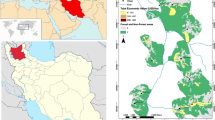Abstract
Sustainable extraction of non-timber forest products (NTFPs) depends upon harvesting a small fraction of the total productivity. Over-exploitation can lead to a loss of biodiversity, but a low level of extraction, without value addition at the point of origin, is usually not economically feasible for extractors. Extraction and productivity levels per unit area for most non-timber forest products are unknown, nor do we have much information about value addition at various points in the marketing channels. Here we determine extraction and productivity levels for Amla trees (Phyllanthus emblica), which yield fruits that are used for a wide variety of purposes in preparation of various foods, beverages and medicines. We also present preliminary data on the price appreciation of the fruit for one of the processed products. We have determined that the current level of extraction, 60-80% of all fruits at the population level, may have a negative effect on new recruitment. We present a model for value addition that has the potential to enhance income and reduce the level of extraction. This model is currently being implemented by the Soliga community with the assistance of a non-governmental organization.
Résumé
A exploração sustentável dos recursos florestais não madereiros esta baseada na extração de uma pequena fração da produtividade total desses recursos. A exploração excessiva pode levar a perda da biodiversidade, e por outro lado, a exploração em pequena quantidade pode ser economicamente inviável. Níveis de extraçáo e produtividade por unidade de área são desconhecidos para grande parte desses recursos, assim como informaçóes sobre valores adicionais em vários pontos dos canais de mercado. Neste trabalho, nós determinamos niveis de extraçáo e produtividade para frutos de Amla (Phyllanthus emblica), os quais são utilizados na preparação de comidas e medicamentos. Nós apresentamos dados preliminares de apreciaçáo de preço do fruto para um dos produtos processados. Nós determinamos também que o nível de extração atual, 60-80% de todos os frutos produzidos a nível de população, pode ter um efeito negativo no recrutamento de plântulas. Nós apresentamos um modelo de valor aditivo que tem o potencial de aumentar a renda e reduzir o nível de extração. Este modelo está atualmente sendo implementado pela comunidade Soliga com a assistência de uma organização não governamental.
Similar content being viewed by others
Literature cited
Bawa, K. S., and M. Gadgil. 1997. Ecosystem services, subsistence economies and conservation of biodiversity.In G. Daily, ed., Ecosystem services: their nature and value. Island Press, Washington, DC. (in press).
Browder, J. O. 1992. Social and economic constraints on the development of market-oriented extractive reserves in Amazon rain forests. Pages 33–42in D. C. Nepstad and S. Schwartzman, eds., Non-timber products from tropical forests: evaluation of a conservation and development strategy. Advances in Economic Botany 9. The New York Botanical Garden, Bronx, NY.
Constanza, R., and H. Daly. 1992. Natural capital and sustainable development. Conservation Biology6:37–46.
Godoy, R., andK. S. Bawa. 1993. The economic value and sustainable harvest of plants and animals from the tropical rain forest: assumptions, hypotheses, and methods. Economic Botany 47:215–219.
Hall, P., and K. S. Bawa. 1993. Methods to assess the impact of extraction of non-timber forest products on plant populations. Economic Botany47: 234–247.
Hegde, R., S. Suryaprakash, L. Achoth, andK. S. Bawa. 1996. Extraction of non-timber forest products in the forests of Biligiri Rangan Hills, India. 1. Contribution to rural income. Economic Botany50:243–251.
Homma, A. K. O. 1992. The dynamics of extraction in Amazonia: a historical perspective. Pages 23–31in D. C. Nepstad and S. Schwartzman, eds., Nontimber products from tropical forests: evaluation of a conservation and development strategy. Advances in Economic Botany 9. The New York Botanical Garden, Bronx, NY.
Janzen, D. H. 1971. Seed predation by animals. Annual Review of Ecology and Systematics 2:465–492.
Krishnamurthy, T. 1993. Minor forest products of India. Oxford & IBH Publishing Co., Pvt. Ltd.
Murali, K. S., Uma Shankar, R. Uma Shaanker, K. N. Ganeshaiah, andK. S. Bawa. 1996. Extraction of non-timber forest products in the forests of Biligiri Rangan Hills, India. 2. Impact of NTFP extraction on regeneration, population structure, and species composition. Economic Botany 50:252–269.
Muthanna, M. M. 1935. Revised working plan report of the Chamarajanagar State Forest, Mysore district, Karnataka Forest Department, Mysore.
Nepstad, D. C, I. F. Brown, L. Luz, A. Alechandra, and V. Viana. 1992. Biotic impoverishment of Amazonian forests by tappers, loggers and cattle ranchers. Pages 1–14in D. C. Nepstad and S. Schwartzman, eds., Non-timber products from tropical forests: evaluation of a conservation and development strategy. Advances in Economic Botany 9. The New York Botanical Garden, Bronx, NY.
Pulliam, H. R. 1988. Sources, sinks, and population regulation. American Naturalist 132:652–665.
Ramesh, B. R. 1989. Evergreen forests of the Biligirirangan Hills, South India. Doctorate Dissertation. French Institute, Pondicherry, India.
Author information
Authors and Affiliations
Rights and permissions
About this article
Cite this article
Shankar, U., Murali, K.S., Uma Shaanker, R. et al. Extraction of non-timber forest products in the Forests of Biligiri Rangan Hills, India. 3. Productivity, extraction and prospects of sustainable harvest of amla phyllanthus emblica, (Euphorbiaceae). Econ Bot 50, 270–279 (1996). https://doi.org/10.1007/BF02907331
Received:
Accepted:
Issue Date:
DOI: https://doi.org/10.1007/BF02907331




